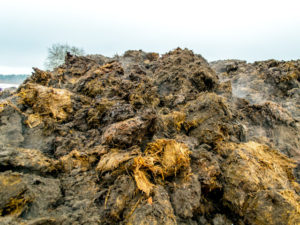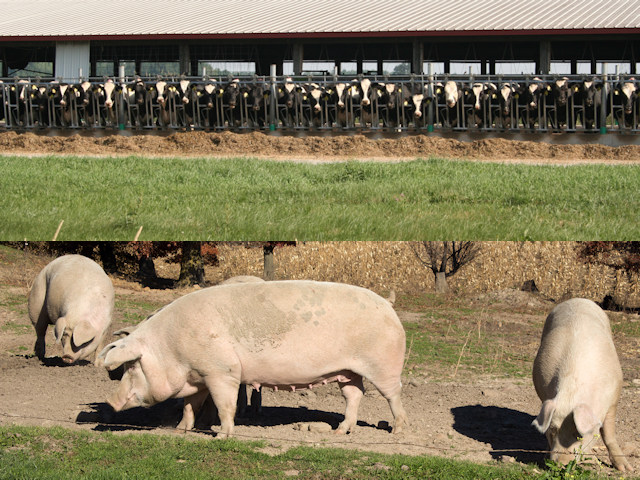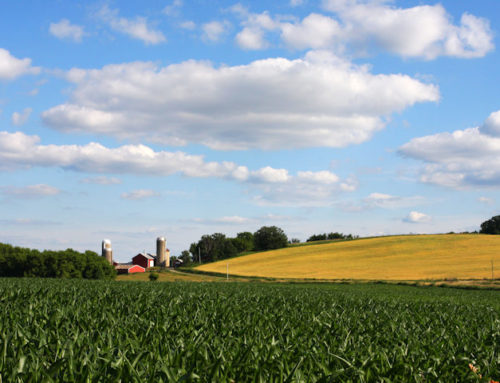How much land depends on the amount of manure.
Obviously, the amount of manure depends on the amount of livestock. More livestock generates more manure, which means more land is necessary for spreading manure. Much of this post is very familiar to agricultural facilities. For some of us, it brings an appreciation and perspective that is not likely embraced by everyone. Please note that my calculations are approximate and the values used need to be confirmed by additional sources.
By all means, I am not an expert on manure management. I am a geophysicist and I characterize what is below the ground without digging. On the other hand, I am interested in having some idea of the amount of land required for farmers and agricultural facilities in Wisconsin. The regulations are extensive and have many details that I do not deal with. To better address concerns with NR 151, I have compiled some interesting facts. Most of the information comes from the “USDA’s Animal Manure Management program RCA Issue Brief #7 December 1995.”
How much manure are we talking about?

Solid manure waste has its own classification.
The 1995 USDA handbook states every 1000 pounds of laying chickens, hogs and pigs (growers), and beef with a high foraging diet produces about 59 to 63 lbs of manure per day. Every 1000 pounds of lactating dairy cows and broiler chickens produce about 80 pounds of manure per day. Next, one needs to know the average weight of each animal to calculate how much manure is produced. In 1985 the Livestock Waste Facilities Handbook, Midwest Plan Service stated an average Holstein cow weighs about 1400 pounds. It reports that 1400 pound dairy cattle produce about 115 pounds per day, 1.85 cubic feet per day, or 13.9 gallons per day. One could probably use these values to convert the production rates for other livestock to cubic feet per day or gallons per day.
Solid Manure
NR 151 permits the spreading of less 15 tons of solid manure to an acre per year. An average 1400 pound Holstein produces 115 pounds per day or 41,975 pounds per year. This is equal to a little less than 21 tons per year. From a solid manure standpoint, it takes 1.4 acres per year to accommodate the 1400 pound Holstein. From a practical point of view, please note that there are other variables that may be more restrictive.
Liquid Manure
On the other hand, liquid manure application rates are measured in gallons per acre over various periods. An average sandy-clay with bedrock between 3 and 5 feet can apply 13,500 gallons per acre in a week (check NR 151). Take the same 1400 pound Holstein and it produces more than 13.9 gallons per day, if it is undiluted or not liquefied. To the best of my findings, liquefied manure is about 10% solids where solid manure is about 20%. Thus, one more or less doubles the liquid volume to reduce the solid fraction to 10%.
In other words, I calculate that 13.9 gallons per day of solid waste is about 28 gallons per day liquefied. Thus, the average 1400 pound Holstein produces roughly 10,220 gallons per year of liquefied manure. If the liquid spreading application is only once a week in a year than the Holstein needs a minimum of 0.75 acres per year. While these applications are allowed on a weekly basis, repeated applications may lead to excessive volumes of manure that can damage crops. Thus, one certainly needs to consult an agricultural specialist.

Liquid manure waste has numerous classifications in NR 151.
Conclusions
Lactating dairy cows and broiler chickens produce some of the most manure on a daily basis, per 1000 pounds of animal weight. Since my research focused on the dairy industry, I conducted some quick calculations, which need confirmation. These calculations suggest that an average 1400 pound Holstein requires about one and a half acres per year for spreading solid manure. By the same token, the same Holstein uses about three quarters of an acre, if the manure is liquefied. Unlike solid manure, rates of application for liquefied manure are measured on a weekly basis and are repeated. In short, it appears (others need to confirm this for themselves) three quarters to one and a half acres of land are needed per 1400 pound Holstein, depending on application rates, soil types, and depth to bedrock.

Size and type of agricultural facility drives how much land is required for nutrient management.







